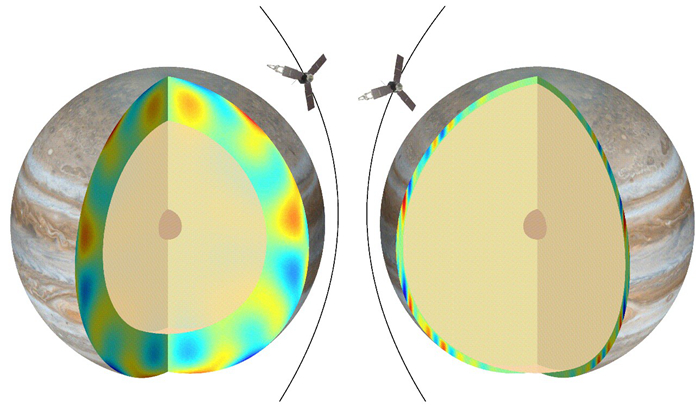One of the most spectacular display of Jupiter is its banded flow features. They are associated with zonal (east-west) winds. However, the origin of this banded flow is still a mystery. It has long been debated that how deep the observed cloud-top zonal winds can penetrate to Jupiter’s interior. The Juno spacecraft which entered the orbit of Jupiter in 2016, is aiming to reveal the story of Jupiter’s formation and evolution. Has Juno solved the mysterious origin of the Jupiter’s zonal winds?
A research team led by Dr. KONG Dali from Shanghai Astronomical Observatory (SHAO), Chinese Academy of Sciences found that multiple possibilities of zonal winds structure could exist using the Juno spacecraft’s measurements. They also present some weaknesses in the earlier influential paper published on Nature. This work has been published on one of the top 4 famous periodicals, the Proceedings of the National Academy of Sciences of the United States of America (PNAS, doi: 10.1073/pnas.1805927115).
In this March, based on the JUNO spacecraft’s measurement, one paper written by Kaspi et al. (doi: 10.1038/nature25793) concluded that Jupiter’s atmospheric zonal winds extend thousands of kilometers deep. This research is supposed to be a historic milestone in human being’s efforts of understanding Jupiter.
However, another recent research led by Dr. KONG Dali from SHAO argues that the reported 3000-kilometer depth of winds is not necessarily true. It also suggests that even with JUNO’s data, the structure of Jupiter’s zonal winds is likely to remain mysterious.
According to Dr. KONG Dali from SHAO, the first author of the PNAS paper, multiple possibilities of zonal winds structures can exist. They are all able to account for the same gravitational field measured by the JUNO spacecraft.
KONG said, “Kaspi et al. studied the problem based on a priori assumption of the structure of zonal winds that extend straightforwardly from surface into deep. This artificial assumption, without any physical reason, has ruled out other possibilities of winds structures. Therefore, their result of 3000-kilometer depth of winds cannot be necessarily regarded as the truth.”
In KONG’s work, no assumption of zonal winds structure is made and finally at least two types of zonal winds are discovered. Both are consistent with measured Jovian gravitational field, as demonstrated in the Figure 1.
“ Our results indicate that the current JUNO spacecraft’s measurements of Jovian gravity cannot distinguish among all possible scenarios of zonal winds and hence are not yet able to solve the existing puzzle”, said Prof. ZHANG Keke from University of Exeter, the second author of the PNAS work.
Dr. Kong emphasized, to remove the non-uniqueness in inverting interior properties from gravity data only, other independent means after including Jupiter’s earthquake or magnetic field may act a key role in the future to constrain Jupiter’s interior. He also believes future Chinese Jupiter missions may be scientifically crucial when this problem is re-visited.

Figure 1: Two types of Jovian zonal winds structures can account for the gravitational field measured by JUNO spacecraft. Apparently they show completely different characteristics. Image Credit: KONG D., et al. 2018
Link to the research paper:
Kong et al. 2018, doi: 10.1073/pnas.1805927115
Science Contact:
KONG Dali, Shanghai Astronomical Observatory, dkong@shao.ac.cn
News Contact:
ZUO Wenwen, Shanghai Astronomical Observatory, wenwenzuo@shao.ac.cn